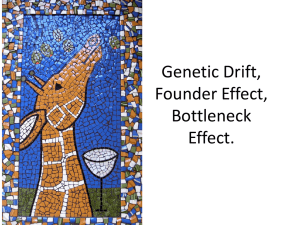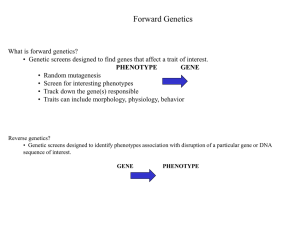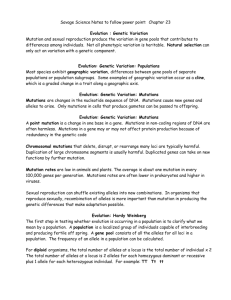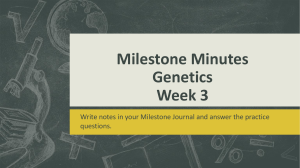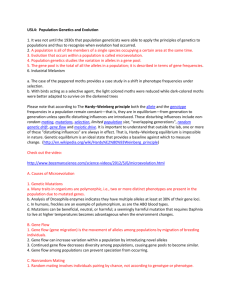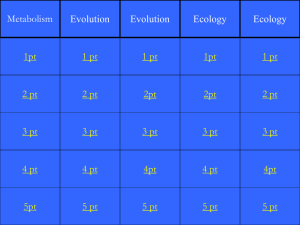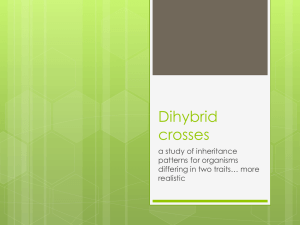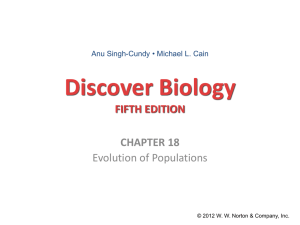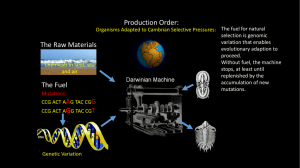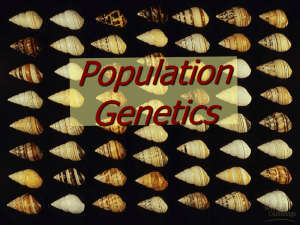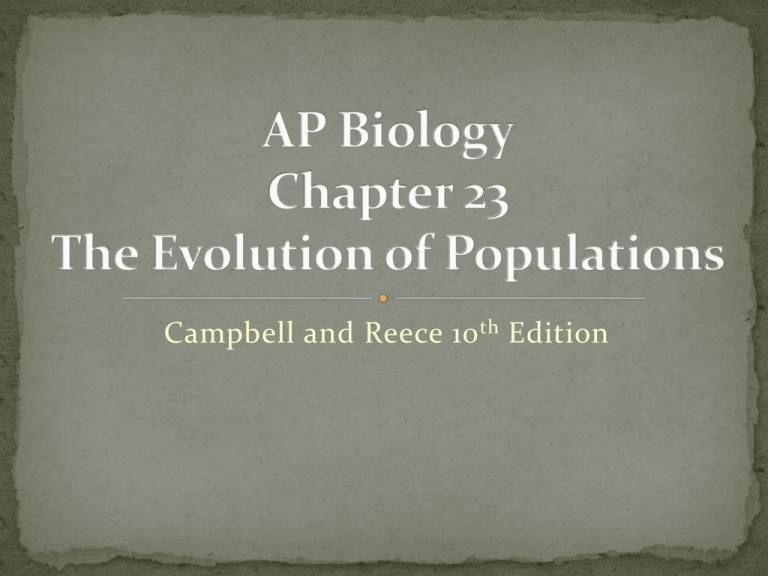
Campbell and Reece 10 th Edition
Medium Ground Finch
from island of Daphne
Major in Galápagos
Islands
Long period of
Individuals do not
evolve, populations do
drought altered their
food supply to mostly
larger nuts & over the
years those individuals
with larger beaks were
more successful
Average beak size
& size of
individual birds
larger after the
drought so….
The medium
ground finch
population had
evolved by natural
selection
Darwin reasoned
that natural
selection acted on
genetic variation
of populations
He knew nothing
about genes
Few yrs later:
Mendel’s paper on
inheritance in pea
plants: stage set
for understanding
variation
Genotype
inheritable,
phenotypes are not
Example: moth,
Nemoria arizonaria,
appears very
different eating oak
flowers vs. oak leaves
In general, only the
genetically determined
part of a phenotype can
affect evolution
Discrete characters =
“either/or” ( Mendel’s pea)
= single gene
Most heritable variations
involve quantitative
characters: vary along a
continuum ≥ 2 genes
way to quantify gene variability
average % of loci that are heterozygous
can calculate average: turns out if the
average heterozygosity is 14% there is
enough genetic variation for natural
selection to act evolutionary change
does not show silent
mutations (DNA
changes but still
codes for same a.a.)
Geographic Variation
differences in genetic
composition of
separate populations
Mutation
Gene Duplication
Sexual Reproduction
Other process that results in new alleles
or new genes
Organisms with short life spans new
genetic variants arise fairly rapidly
1.
Mutations
can’t predict where in genome or what type
mutation
for multicellular organisms only
mutations in gametes cell line passed to
new generations (most are in somatic cell
line)
most point mutations silent or only
slightly harmful, rarely are they beneficial
chromosomal changes that delete,
disrupt, or rearrange usually lethal or
harmful
if genes left intact they may be neutral
changes
Translocation:
Part of 1 chromosome breaks off & attaches
to another chromosome
if large segments duplicated usually harmful
duplications of small pieces may be beneficial
mutations accumulate over time
eventually that duplication takes on new role
end result: expanded genome
average mutation rate in plants & animals is
considered low
~ 1 mutation in every
100,000 genes / generation
shorter generation
spans allows for
generation of
genetic variation in
a population
virus populations,
especially
retroviruses
process is fastest
single stranded
RNA:
less complicated
to duplicate
fewer RNA repair
mechanisms in
host cells
most effective
treatment for a
quickly mutating
retrovirus has
been combination
protocols
most of genetic
variation due to
crossing over and
independent
assortment of
chromosomes in
meiosis and
fertilization
1 of 3 factors that
presence of
genetic variation
does not
guarantee that
population is
evolving
cause evolution
must be at work
in a population
Population: group
of same species in
same area that
interbreed, with
fertile offspring
examples of
isolated
populations:
Islands
Lakes
even populations
not strictly
isolated members
tend to breed with
own population so
are genetically
closer to them
than other groups
consists of
all copies of
every allele
at every
locus in all
members of
a population
if there is only 1
allele for a locus
that allele is said
to be fixed in the
gene pool; entire
population is
homozygous for
that gene
if there are 2 or
more alleles for a
locus then
individuals may be
homozygous or
heterozygous
to test whether natural selection is
acting on a particular locus:
Determine what the frequency would be
if it were not evolving
Then compare that calculation with what
you measure in the population
No difference: not evolving
difference: evolving
Hardy
Weinberg
states that the frequencies of alleles &
genotypes in a population will remain
constant from generation to generation,
provided that only Mendelian
segregation & recombination of alleles
are at work
If that is true the population is said to be
in HARDY-WEINBERG EQUILIBRIUM
http://nhscience.lonestar.edu/biol/hwe/q1d.html
http://www.phschool.com/science/biology_place/labb
ench/lab8/intro.html
Problem 2:
If 9% of an African population is born
with a severe form of sickle cell
anemia (ss) what % of the population
will be more resistant to malaria
because they are heterozygous (Ss) for
the sickle-cell gene?
2pq = 2 (.7 x .3) = .42 = 42% of the population are
heterozyotes (carriers)
1. No Mutations
2. Random Mating
3. No Natural Selection
4. Extremely Large Populations
5. No Gene Flow
Departure from any of the 5 conditions
usually results in evolutionary changes
A population may be evolving at some
gene loci and in Hardy-Weinberg
Equilibrium at other loci
Can be used to estimate the frequency of
a gene causing inherited disease in a
population
Must assume:
No new mutations
Random mating
Ignore any effects of differential survival
& reproductive success
No genetic drift
1.
2.
3.
4.
5.
No Mutations: not usually significant unless
mutation produces new alleles that have a
strong influence in a (+) or (-) way
Random Mating: not usually significant
No Natural Selection
cause most
Extremely Large Populations
evolutionary
No Gene Flow
change
is based on differential success in
survival & reproduction
if NS consistently favoring some alleles
over others, NS can cause adaptive
evolution (dfn: evolution that results in
a better match between organisms &
their environment)
process in which chance events cause
unpredictable fluctuations in allele
frequencies from one generation to the
next
the smaller the population the more
pronounced the effect
1. Founder Effect
genetic drift that occurs when a few
individuals become isolated from a
larger population & form a new
population whose gene pool
composition is not reflective of
original population
1 colonist carried recessive allele for
retinitis pigmentosa
By late 1960’s, there were 240
descendants of the original founders
4 had retinitis pigmentosa
This frequency is 10x higher than
frequency of retinitis pigmentosa in
England
2. Bottleneck Effect:
occurs when the size of a population is
reduced, as by a natural disaster or
human actions. The resulting
population is genetically different than
original population.
Genetic Drift :
1. is significant in small populations
2. can cause allele frequencies to change
at random
3. can lead to a loss of genetic variation
w/in populations
4. can cause harmful alleles to become
fixed
the transfer of alleles from one
population to another as result of
movement of fertile individuals or their
gametes
transferred alleles may increase a
population’s ability to adapt to local
conditions
Culex pipiens
spread of insecticideresistant alleles used
to treat mosquitoes to
prevent spread of West Nile
outcome of NS is not random
NS increases frequencies of alleles that
provide reproductive advantage so, leads
to adaptive evolution
NS acts directly on the phenotype &
indirectly on the genotype
the contribution an individual makes to
the gene pool of the next generation,
relative to the contribution of other
individuals in the population
1. DIRECTIONAL SELECTION
conditions favor individuals favoring
one extreme of a phenotype
shifts curve in one direction or other
2. DISRUPTIVE SELECTION
conditions favor individuals at both
extremes of a phenotypic range over
individuals with intermediate
phenotypes
3. STABILIZING SELECTION
conditions favor the intermediate
phenotype and act against both
extremes
reduces variation
Natural selection will increase the
frequencies of alleles that enhances
survival & reproduction so… over time
adaptations arise
genetic drift & gene flow may cause
changes that are either advantageous or
disastrous
individuals with certain inherited
characteristics are more likely to obtain
mates
can result in sexual dimorphism:
marked differences between the 2• sex
characteristics
1. Intrasexual Selection
selection w/in same sex
Alpha male
2. Intersexual Selection
aka mate choice
females choosy about their mate (often
depends on male showiness)
1 hypothesis:
females have linked “good genes” with
trait
study: gray tree frog
2nd hypothesis
females have linked “good health” with
these traits
study: birds
neutral variation: differences in DNA
that do not confer an advantage or
disadvantage
Why don’t all genes move toward
neutrality?
tendency for directional or stabilizing
selection countered by mechanisms that
preserve or restore variation
recessive alleles hidden and carried
forward in heterozygotes
heterozygote protection maintains a
huge pool of alleles that might not be
favored under present conditions, but
could bring benefits in environment
changes
occurs when natural selection maintains
2 or more forms in a population
2 types:
heterozygote advantage
2. frequency-dependent selection
1.
Heterozygotes have survival advantage
If phenotype of a heterozygote is
intermediate between the 2
homozygotes then this advantage is:
stabilizing selection
If phenotype of heterozygote same as
dominant homozygote this advantage is
directional selection
Example: Sickle Cell
SS
homozygous dominant
no protection against malaria
Ss
heterozygous
protection against malaria
few sickle cells but not harmful
ss
homozygous recessive
die young of sickle cell
the fitness of a phenotype depends on
how common it is in the population
eat scales off
flank of prey
some leftmouthed some
right-mouthed
right-mouthed
dominant to leftmouthed
selection favors
whichever mouth
phenotype is least
common (prey
fish learn to avoid
attacks from more
common
1. Selection can only
act on existing
variations
NS favors only
the fittest
available
phenotypes
2.
Evolution is limited
by historical
constraints
NS has to work
with existing
structures
3. Adaptations are
often compromises
each organisms
must do many
things: some
structures are a
compromise (Walrus
fins great for swim,
not so good for
walking on rocks)
4. Chance, natural
selection, & the
environment
interact
founding
population may not
carry “best” alleles
for new
environment;
environments can
change


